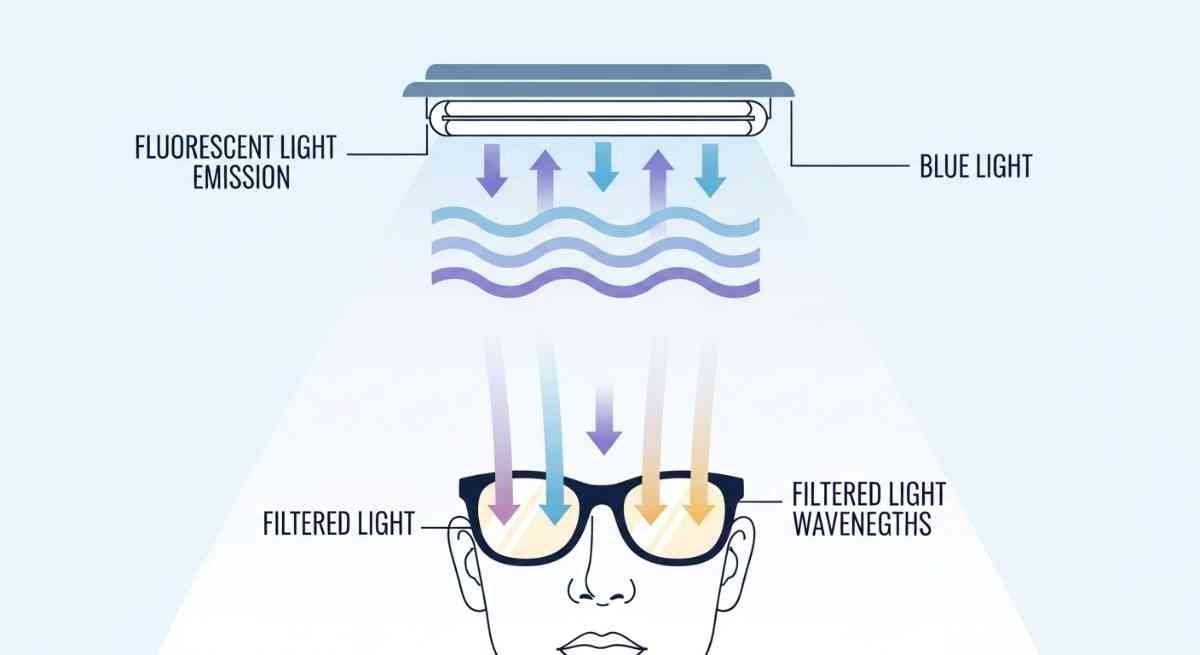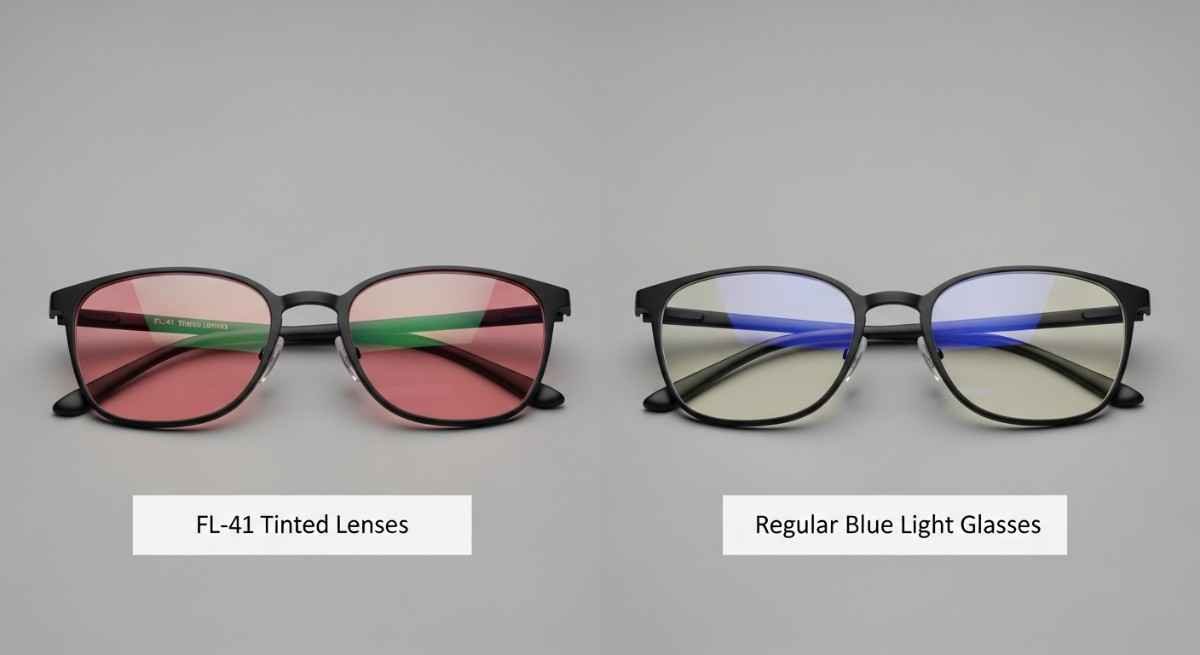Introduction
If you’ve ever walked into an office, classroom, or retail store and immediately felt your eyes strain under the harsh overhead lighting, you’re not alone. Fluorescent lighting—once considered an energy-efficient miracle—has become a common source of discomfort for millions of people worldwide. The buzzing hum, the flickering quality, and the peculiar color temperature all contribute to a phenomenon known as fluorescent light sensitivity, leaving many searching for relief.
Enter blue light glasses: the trendy eyewear solution that’s been marketed heavily for screen time protection. But do these glasses actually help with fluorescent lighting? Can they reduce the headaches, eye strain, and sensory overload that many experience under artificial indoor lighting?
In this comprehensive guide, we’ll explore the science behind fluorescent lighting and its effects on your eyes, examine whether blue light glasses help with fluorescent lights, compare different lens technologies like FL-41 filters, and provide evidence-based recommendations for managing light sensitivity. Whether you’re an office worker battling daily migraines, a student struggling in bright classrooms, or someone with photophobia seeking practical solutions, this article will give you the information you need to make an informed decision.
How Fluorescent Lighting Affects the Eyes
Before we can answer whether blue light glasses help with fluorescent lighting, we need to understand what makes these lights so problematic in the first place.

The Science Behind Fluorescent Bulbs
Fluorescent lights work differently than traditional incandescent bulbs. They contain mercury vapor that produces ultraviolet light when electrified. This UV light then interacts with a phosphor coating inside the bulb to create visible light. While this process is energy-efficient, it creates several issues:
Invisible Flicker: Fluorescent lights flicker at a rate typically between 100-120 times per second. While this flicker is usually too fast for conscious perception, research suggests that your brain and visual system still process these rapid changes. This invisible flicker can lead to eye strain, headaches, and even affect concentration and mood.
Unbalanced Light Spectrum: Unlike sunlight or incandescent bulbs that produce a full, continuous spectrum of light, fluorescent bulbs emit light in specific wavelength peaks. They’re particularly strong in the blue-violet range (400-500 nm) and often weak in red wavelengths, creating an unnatural color temperature that can feel harsh and uncomfortable.
High-Energy Visible (HEV) Light: Fluorescent bulbs emit significant amounts of high-energy visible light, particularly in the blue-violet spectrum. This type of light penetrates deeper into the eye and requires more focusing effort from your visual system, potentially contributing to fatigue.
Common Symptoms of Fluorescent Light Sensitivity
People who experience light sensitivity and fluorescent lighting issues report a wide range of symptoms:
- Persistent headaches or migraines that develop within 20-60 minutes of exposure
- Eye strain, burning, or a gritty sensation in the eyes
- Difficulty concentrating or reading under fluorescent lights
- Increased anxiety or sensory overwhelm
- Blurred vision or visual disturbances
- Neck and shoulder tension from squinting or attempting to avoid the light
- Fatigue and reduced productivity
These symptoms can significantly impact quality of life, particularly for those who work or study in fluorescent-lit environments for hours each day.
Who Is Most Vulnerable?
While anyone can experience discomfort from fluorescent lighting, certain populations are particularly susceptible:
- Individuals with migraine disorders
- People with autism spectrum conditions who experience sensory sensitivities
- Those with photophobia (light sensitivity) from various causes
- People with certain eye conditions like dry eye syndrome or light-colored irises
- Individuals taking photosensitizing medications
Do Blue Light Glasses Help With Fluorescent Lighting?
Now for the central question: do blue light glasses help with fluorescent lighting? The answer is more nuanced than a simple yes or no.
Understanding Blue Light Filtering Technology
Standard blue light glasses typically feature lenses with a coating or tint designed to filter out blue wavelengths, usually in the 400-450 nanometer range. These glasses were originally marketed primarily for digital device use, with manufacturers claiming they could reduce digital eye strain and improve sleep quality.
The filtering mechanism works by either:
- Absorption: The lens material itself absorbs blue wavelengths
- Reflection: A special coating reflects blue light away from the eye
- Combination: Both absorption and reflection technologies work together
Most consumer blue light glasses block approximately 10-50% of blue light, though the exact percentage varies widely by brand and price point.
When Blue Light Glasses May Help
Blue light glasses for fluorescent lights can provide some benefit in specific situations:
Reducing Bright Light Glare: The slight tint in blue light glasses (often a subtle yellow or amber hue) can help reduce the overall brightness and harsh quality of fluorescent lighting, making the environment feel more comfortable. This is similar to how wearing sunglasses makes a bright day more manageable.
Partial Blue-Violet Spectrum Filtering: Since fluorescent bulbs emit concentrated blue-violet wavelengths, and blue light glasses target this spectrum, there can be some reduction in the specific wavelengths that contribute to discomfort and visual strain.
Psychological Comfort: For some individuals, simply wearing glasses specifically chosen to address their light sensitivity can provide a sense of control and may reduce anxiety associated with entering fluorescent-lit spaces.
When Blue Light Glasses May Not Be Enough
However, it’s important to understand the limitations:
Limited Protection Against Flicker: The primary mechanism of discomfort from fluorescent lighting is often the invisible flicker, not just the blue wavelengths. Standard blue light glasses do nothing to address flicker-induced eye strain and headaches.
Insufficient Filtering Percentage: Most consumer blue light glasses only filter a modest percentage of blue light. For someone with significant fluorescent light sensitivity, this may not provide adequate relief.
Wrong Wavelength Focus: Many blue light glasses are optimized for digital screens, which emit peak blue light around 450-455 nm. Fluorescent bulbs have a different spectral distribution, with strong emission lines around 435 nm and 545 nm (blue-green). Standard blue light glasses may not effectively target the specific wavelengths causing your discomfort.
What the Research Says
Scientific studies on blue light glasses specifically for fluorescent lighting are limited, but related research offers insights:
A study examining the effects of blue-blocking lenses found that they could reduce certain types of light-induced discomfort, but the effects varied significantly based on the percentage of blue light blocked and the individual’s specific sensitivities.
Research on photophobia suggests that filtering blue wavelengths can help some individuals, but comprehensive filtering of the 480-500 nm range (blue-green light) may be more effective than targeting only the shorter blue wavelengths that most consumer glasses address.
The consensus among vision scientists is that while blue light filtering may provide modest benefits for some people experiencing indoor lighting eye strain, it’s rarely a complete solution for fluorescent light sensitivity.

FL-41 Glasses vs Regular Blue Light Glasses
If standard blue light glasses have limitations for fluorescent lighting, what alternatives exist? This is where FL-41 filter glasses come into the picture.
What Are FL-41 Lenses?
FL-41 lenses feature a specialized rose-tinted filter originally developed in the 1990s specifically for people with light sensitivity and migraines. Unlike standard blue light glasses, FL-41 lenses were designed from the ground up to address photophobia and fluorescent light discomfort.
The distinctive rose or amber tint of FL-41 lenses filters approximately 80% of blue light and about 50% of green light, providing much more comprehensive protection than standard blue light glasses.
Key Differences in Technology
Wavelength Targeting: FL-41 lenses block a broader range of problematic wavelengths, including the 480-500 nm range (blue-green) that research suggests may be particularly triggering for migraine sufferers and those with light sensitivity. Standard blue light glasses primarily target the 400-450 nm range.
Filtering Intensity: FL-41 lenses filter significantly more light overall—approximately 50-80% of targeted wavelengths—compared to the 10-50% typical of consumer blue light glasses.
Color Rendition: The distinctive rose tint of FL-41 lenses affects how you perceive colors, which can take some adjustment. Standard blue light glasses typically have a much subtler tint that causes minimal color distortion.
Visible Light Reduction: FL-41 lenses also reduce overall brightness by approximately 20%, which can help with the harsh quality of fluorescent lighting beyond just wavelength filtering.
Scientific Evidence for FL-41 Lenses
Research specifically examining FL-41 lenses has shown more promising results for light sensitivity than studies on standard blue light glasses:
Multiple studies have found that FL-41 lenses can significantly reduce photophobia symptoms and migraine frequency in susceptible individuals. One study found that patients with light-sensitive migraines who wore FL-41 lenses experienced a reduction in migraine frequency and intensity.
Research examining glasses for photophobia has indicated that the specific wavelength filtering profile of FL-41 lenses aligns well with the sensitivity peaks identified in people with various forms of light intolerance.
Practical Comparison
| Feature | Standard Blue Light Glasses | FL-41 Lenses |
|---|---|---|
| Primary Purpose | Digital screen use | Light sensitivity & photophobia |
| Blue Light Blocked | 10-50% | ~80% |
| Green Light Blocked | Minimal | ~50% |
| Lens Tint | Minimal (slight yellow) | Noticeable (rose/amber) |
| Color Distortion | Very low | Moderate |
| Cost | $20-$150 | $80-$300+ |
| Prescription Options | Widely available | Available but more specialized |
| Research Support | Limited for fluorescent lights | More robust for light sensitivity |
Which Should You Choose?
Consider standard blue light glasses if:
- Your fluorescent light discomfort is mild to moderate
- You want a subtle solution that doesn’t significantly change color perception
- You’re on a budget and want to try filtering as a first step
- You also want to use the glasses for digital screen work
Consider FL-41 lenses if:
- You experience significant photophobia or light-triggered migraines
- Standard blue light glasses haven’t provided adequate relief
- You can adjust to the color tint (many users adapt within days to weeks)
- You need glasses specifically for fluorescent light sensitivity rather than screen use
Who Benefits Most From Fluorescent Light Filtering Glasses
Understanding who experiences the greatest relief from filtering glasses can help you determine if they’re worth trying for your situation.
Migraine Sufferers
People with migraine disorders, particularly those with light-sensitive migraines (also called photophobic migraines), often find significant relief from specialized filtering glasses. Research indicates that fluorescent lighting is a common migraine trigger, with the flicker and blue-green wavelengths playing significant roles.
Migraine glasses for bright lighting can help by:
- Reducing the intensity of triggering wavelengths
- Decreasing overall brightness that can initiate or worsen migraine episodes
- Providing prophylactic protection when entering known trigger environments
Many migraine specialists now recommend FL-41 lenses as part of a comprehensive migraine management strategy.

Individuals with Autism and Sensory Processing Differences
Fluorescent lighting is frequently reported as problematic by autistic individuals and those with sensory processing sensitivities. The combination of flicker, brightness, and unnatural spectrum can contribute to sensory overload, anxiety, and reduced ability to focus.
Studies examining sensory interventions for autism have found that environmental modifications, including appropriate eyewear, can improve comfort and function in challenging environments. While more research is needed, anecdotal reports from the autism community suggest that filtering glasses can be a helpful tool for managing sensory input in fluorescent-lit spaces like schools, offices, and stores.
Office Workers and Students
Anyone who spends extended hours under fluorescent lighting may benefit from filtering glasses, even without diagnosed light sensitivity or migraine disorders. The cumulative effects of indoor lighting eye strain can manifest as:
- End-of-day headaches
- Difficulty maintaining focus in afternoon hours
- Visual fatigue that impacts reading and computer work
- General discomfort in the work or study environment
For these individuals, even modest filtering from standard blue-blocking lenses for overhead lights may provide noticeable improvements in comfort and productivity.
People with Specific Eye Conditions
Certain eye conditions can increase vulnerability to fluorescent lighting discomfort:
Dry Eye Syndrome: Fluorescent lighting can exacerbate dry eye symptoms by decreasing blink rate and increasing environmental stress on the ocular surface. Filtering glasses may help by reducing the overall visual stress that contributes to reduced blinking.
Light-Colored Irises: People with lighter eye colors (blue, green, or hazel) have less melanin pigment in their irises, which means less natural protection against bright light and glare. Filtering glasses can compensate for this reduced natural protection.
Post-Concussion Syndrome: Individuals recovering from concussions or traumatic brain injuries often develop temporary or lasting photophobia. Specialized filtering glasses are frequently recommended as part of post-concussion rehabilitation.
Healthcare and Retail Workers
Healthcare facilities and retail environments often rely heavily on fluorescent lighting, and workers in these settings may have little control over their lighting environment. For these professionals, filtering glasses can be an essential tool for managing symptoms during long shifts.
Case Studies & Real-Life Examples
Understanding how filtering glasses work in real-world situations can help you assess their potential benefit for your circumstances.
Case Study 1: Corporate Office Environment
Sarah, a 34-year-old marketing manager, began experiencing daily headaches about an hour into her workday at her new office. The open-plan workspace featured extensive fluorescent lighting that she suspected was the culprit. Traditional pain relievers provided only temporary relief.
Initial Intervention: Sarah started with standard blue light glasses purchased online for approximately $40. She noticed a modest improvement—headaches were slightly less intense and occurred later in the day—but the problem persisted.
Second Attempt: After consulting with an optometrist who specialized in photophobia, Sarah invested in FL-41 prescription lenses at a cost of about $250. Within the first week, she noticed a dramatic improvement. Headaches occurred only once or twice per week instead of daily, and were significantly less severe when they did occur.
Key Takeaway: For moderate to severe fluorescent light sensitivity, specialized filtering (FL-41) often provides better results than standard blue light glasses. The higher upfront cost was justified by the significant improvement in quality of life and work productivity.
Case Study 2: Classroom Setting
Marcus, a 12-year-old student with autism, struggled significantly in his middle school classroom, which had particularly bright fluorescent lighting. His parents reported that he often came home exhausted, irritable, and unable to focus on homework. His teachers noticed that he seemed distracted and frequently covered his eyes or looked down at his desk.
Intervention: Working with an occupational therapist, Marcus’s family tried FL-41 filtering glasses. They chose a slightly lighter tint to avoid drawing excessive attention from peers, as social concerns were important for Marcus.
Outcome: Within two weeks, Marcus’s teachers reported improved attention and classroom participation. Marcus himself reported that the classroom felt “less loud” (an interesting synesthetic description suggesting reduced sensory overwhelm). His parents noticed better mood and energy levels after school.
Key Takeaway: For individuals with sensory processing differences, filtering glasses can address more than just eye strain—they can reduce overall sensory load and improve function across multiple domains.
Case Study 3: Retail Environment
Jennifer worked as a cashier in a large retail store with extensive fluorescent lighting. Over two years in the position, she developed increasingly frequent migraines that often forced her to leave work early or call in sick. Her doctor identified fluorescent lighting as a likely trigger.
Multifaceted Approach: Jennifer combined several strategies:
- FL-41 filtering glasses worn throughout her shifts
- Requesting assignment to areas with slightly dimmer lighting when possible
- Taking brief breaks in naturally lit areas (near windows or outside)
- Maintaining a consistent sleep schedule and avoiding other known triggers
Outcome: The combination of interventions reduced Jennifer’s migraines from 2-3 per week to approximately 2-3 per month. While the glasses alone didn’t eliminate all migraines, they were a crucial component of her management strategy.
Key Takeaway: Filtering glasses often work best as part of a comprehensive approach to managing fluorescent light sensitivity, rather than as a single solution.
Case Study 4: Home Office Adaptation
David, a freelance software developer, maintained a home office where he initially installed fluorescent lighting for its energy efficiency. After experiencing eye strain and afternoon headaches, he was reluctant to invest in completely new lighting but wanted a quicker solution.
Approach: David purchased moderately priced blue light glasses (around $60) and made additional environmental modifications:
- Added desk and floor lamps with warmer LED bulbs for task lighting
- Installed diffusers over fluorescent fixtures to reduce glare
- Positioned his desk to take advantage of natural window light
Outcome: The combination of modest filtering and environmental changes proved effective. David’s symptoms improved significantly without requiring expensive FL-41 lenses or a complete lighting overhaul.
Key Takeaway: For mild to moderate sensitivity and situations where you have environmental control, standard blue light glasses combined with other modifications can be sufficient and cost-effective.
Alternatives to Blue Light Glasses for Fluorescent Lights
While filtering glasses can be effective, they’re not the only solution for managing fluorescent light discomfort. In many cases, addressing the lighting environment itself provides equal or superior results.

Replacing Fluorescent Bulbs
The most comprehensive solution is replacing fluorescent lighting with alternatives:
LED Lighting: Modern LED bulbs offer several advantages:
- No flicker (when properly designed and installed)
- Customizable color temperature (choose warmer tones around 2700-3000K)
- Better color rendering index (CRI), making colors appear more natural
- Energy efficient like fluorescents, but without the problematic characteristics
- Longer lifespan than fluorescent bulbs
When selecting LED replacements, look for bulbs specifically labeled as “flicker-free” and with a CRI of 90 or above for the most comfortable lighting quality.
Incandescent or Halogen Options: While less energy-efficient, traditional incandescent or halogen bulbs produce a continuous, full-spectrum light that many people find more comfortable. These can be good options for task lighting or smaller spaces where energy consumption is less of a concern.
Lighting Modifications
If complete replacement isn’t possible, several modifications can improve fluorescent lighting:
Diffusers and Filters: Installing diffusers over fluorescent fixtures softens the harsh quality of the light and reduces glare. Specialized filters that reduce flicker and filter problematic wavelengths are also available for fluorescent fixtures.
Dimmer Switches: Where compatible, installing dimmers allows you to reduce fluorescent light intensity. However, note that dimming fluorescent lights can sometimes worsen flicker, so this should be tested carefully.
Supplemental Lighting: Adding alternative light sources can reduce your dependence on overhead fluorescents:
- Desk lamps with warm LED or incandescent bulbs
- Floor lamps that provide indirect, bounced light
- Natural light from windows whenever possible
Environmental Strategies
Beyond changing the lights themselves, consider these environmental approaches:
Position and Placement: If possible, position your workspace to minimize direct exposure to overhead fluorescents:
- Sit perpendicular to fluorescent fixtures rather than directly under them
- Use partitions or furniture to create some barrier between you and overhead lights
- Take advantage of workspaces near windows for natural light supplementation
Computer Screen Protection: Since many people experience fluorescent light issues while also using computers, consider:
- Anti-glare screen filters that reduce reflection of overhead lighting
- Positioning monitors to minimize reflected fluorescent light
- Adjusting screen brightness to be compatible with room lighting
Break Strategies: Regular breaks in different lighting environments can help:
- Step outside or near windows during breaks
- Rest in areas with alternative lighting types
- Practice the 20-20-20 rule: every 20 minutes, look at something 20 feet away for 20 seconds
Organizational Solutions
In workplace or school settings, systemic changes can benefit multiple people:
Lighting Audits: Encourage facilities management to conduct lighting assessments that consider occupant comfort alongside energy efficiency.
Accommodation Requests: Under disability laws in many countries, individuals with documented light sensitivity may be entitled to reasonable accommodations such as alternative lighting or workspace modifications.
Awareness and Education: Many people are unaware that fluorescent lighting can cause significant discomfort. Raising awareness can lead to organizational willingness to explore alternatives that benefit multiple employees or students.
Pros & Cons of Blue Light Glasses for Fluorescent Lighting
To help you make an informed decision, let’s examine the advantages and limitations of using filtering glasses for fluorescent light sensitivity.
Advantages
Immediate and Portable Solution: Unlike environmental modifications that may require time, permission, or financial investment, glasses provide instant relief that you can take anywhere. This is particularly valuable for people who move between multiple fluorescent-lit environments.
Non-Invasive: Wearing glasses requires no medication, no significant lifestyle changes, and carries essentially no risk of side effects or complications.
Dual Purpose: Many filtering glasses, particularly FL-41 lenses, can help with multiple sources of light sensitivity including sunlight, digital screens, and various types of artificial lighting—not just fluorescents.
Psychological Empowerment: Having a tool to manage light sensitivity can reduce anxiety about entering problematic environments and provide a sense of control over symptoms.
Customizable Options: Filtering glasses are available in prescription and non-prescription versions, various filtering strengths, and multiple frame styles to suit individual needs and preferences.
Evidence-Based Option: Particularly for FL-41 lenses, peer-reviewed research supports their efficacy for reducing photophobia and light-triggered migraines, making them a scientifically sound intervention.
Disadvantages
Limited Effectiveness for Some Users: Not everyone experiences significant relief from filtering glasses. Individual responses vary based on the specific nature of light sensitivity, and glasses may address only part of the problem.
Doesn’t Address Flicker: Filtering glasses do nothing to eliminate the invisible flicker of fluorescent lighting, which is a primary source of discomfort for many people. If flicker is your main issue, glasses alone won’t solve the problem.
Cost Considerations: Quality filtering glasses, particularly FL-41 prescription lenses, can be expensive (often $200-$400 or more). While standard blue light glasses are more affordable, they may not provide adequate relief for significant sensitivity.
Color Distortion: Especially with FL-41 lenses, the noticeable tint changes color perception, which can be problematic for professionals who work with color-critical tasks (designers, artists, photographers) and requires an adjustment period for most users.
Not a Root Solution: Glasses manage symptoms rather than addressing the problematic lighting itself. While this is sometimes necessary and appropriate, ideally problematic fluorescent lighting would be replaced with better alternatives.
Social Considerations: Some people feel self-conscious wearing tinted glasses indoors, particularly in professional settings. While this concern is often overestimated, it can be a barrier to consistent use.
Potential Over-Reliance: Depending exclusively on glasses might prevent individuals or organizations from making beneficial environmental changes that would help everyone, not just those with sensitivity issues.
Finding the Right Balance
The key to successfully using filtering glasses is understanding them as one tool among several for managing fluorescent light sensitivity. They work best when:
- Chosen appropriately for your specific type and severity of sensitivity
- Used consistently in problematic environments
- Combined with other strategies when possible
- Viewed as part of a comprehensive approach rather than a magic solution
For many people, the benefits significantly outweigh the disadvantages, particularly when environmental modifications aren’t possible or as a bridge solution while working toward better lighting alternatives.

Frequently Asked Questions
Do blue light glasses work for fluorescent lights?
Blue light glasses for fluorescent lights can provide modest relief for some people, particularly by reducing brightness and filtering some problematic blue wavelengths. However, standard blue light glasses typically filter only 10-50% of blue light and don’t address the flicker issue that often contributes significantly to fluorescent light discomfort. For mild sensitivity, they may be worth trying. For moderate to severe light sensitivity, specialized options like FL-41 lenses are typically more effective.
Can blue light glasses reduce headaches from fluorescent lighting?
Blue light glasses may help reduce fluorescent lighting headaches for some individuals, but results vary considerably. People whose headaches are primarily triggered by the blue-violet wavelengths emitted by fluorescent bulbs may experience relief. However, if your headaches are mainly caused by flicker or overall brightness rather than specific wavelengths, standard blue light glasses may not provide significant benefit. FL-41 lenses have better research support for reducing light-triggered headaches and migraines.
What type of glasses help with fluorescent light sensitivity?
The most effective glasses for photophobia and fluorescent light sensitivity are FL-41 lenses, which filter approximately 80% of blue light and 50% of green light, providing more comprehensive protection than standard blue light glasses. These rose-tinted lenses were specifically designed for light-sensitive individuals and have the strongest research support. Standard blue light glasses may help with mild sensitivity, while individuals with severe photophobia might need prescription FL-41 lenses customized to their specific needs.
Are FL-41 lenses better than blue-light coatings?
FL-41 filter glasses are generally more effective than standard blue-light coatings for managing fluorescent light sensitivity. FL-41 lenses filter a broader range of wavelengths (including blue-green light around 480-500 nm) and block a higher percentage of problematic light overall. They also reduce total brightness by about 20%, which can help with the harsh quality of fluorescent lighting. Standard blue-light coatings target primarily the 400-450 nm range and filter less light overall, making them more suitable for mild sensitivity or digital screen use rather than significant photophobia.
How long does it take to adjust to FL-41 lenses?
Most people adjust to the rose tint of FL-41 lenses within a few days to two weeks. Initially, the color distortion may be noticeable, but the brain typically adapts and begins compensating for the tint. Some users report that colors appear normal while wearing the glasses after the adjustment period, though they notice the tint again when first putting them on or taking them off. The adjustment is generally easier if you wear the glasses consistently rather than intermittently.
Can I get FL-41 lenses with my prescription?
Yes, FL-41 filtering is available in prescription lenses. You’ll need to work with an optometrist or optical service that offers specialized lens options. Some eye care professionals specialize in treating photophobia and are familiar with FL-41 lenses, while others may need to order them specially. Prescription FL-41 lenses are typically more expensive than non-prescription versions, generally ranging from $250-$400 or more depending on prescription complexity and frame selection.
Do I need to wear filtering glasses all the time?
Most people find that wearing filtering glasses specifically in fluorescent-lit environments is sufficient. There’s no medical need to wear them constantly unless you have severe, widespread photophobia that affects you in various lighting conditions. Many users keep their filtering glasses at work or school and wear regular glasses or contacts in other environments. However, consistent use in trigger environments typically provides better results than intermittent use.
Will filtering glasses affect my night vision or ability to drive?
FL-41 lenses and even tinted blue light glasses can reduce the amount of light entering your eyes, which may slightly affect vision in already dim conditions. Most people should not wear these glasses for nighttime driving, as they can reduce visibility and contrast in low-light situations. Standard blue light glasses with minimal tint are less problematic but may still affect night vision slightly. Always test new glasses in safe conditions and consult with your eye care professional about appropriate use situations.
Are there any side effects of wearing blue light glasses or FL-41 lenses?
Filtering glasses themselves have no significant health side effects—they simply alter which wavelengths of light reach your eyes. However, some users experience a brief adjustment period that may include slight eyestrain or headaches as the visual system adapts to the filtered input. The color distortion from FL-41 lenses can be disorienting initially but typically resolves as you adapt. If you experience persistent problems after a reasonable adjustment period (2-3 weeks), consult with your eye care provider to ensure proper fitting and appropriate filtering strength.
What should I look for when shopping for blue light glasses for overhead lights?
When choosing blue-blocking lenses for overhead lights, consider:
- Filtering percentage: Look for glasses that block at least 30-50% of blue light for meaningful effect
- Wavelength range: Check whether the glasses target the appropriate wavelengths (435-500 nm range is relevant for fluorescent lights)
- Lens quality: Avoid extremely cheap options that may have poor optical quality or inconsistent filtering
- Return policy: Since individual responses vary, choose retailers that allow returns if the glasses don’t help
- Professional guidance: Consider consulting an optometrist, especially if you have prescription needs or severe sensitivity
For significant fluorescent light sensitivity, budget for FL-41 lenses rather than trying multiple cheaper alternatives that may not provide adequate relief.
Conclusion
So, do blue light glasses help with fluorescent lighting? The answer depends significantly on the severity of your sensitivity, the type of glasses you choose, and what specifically about fluorescent lighting causes you discomfort.
Standard blue light glasses can provide modest relief for people with mild fluorescent light sensitivity, primarily by reducing some blue wavelengths and slightly toning down overall brightness. They’re an affordable first step and may be sufficient if your symptoms are occasional or minor. These glasses work best when combined with other strategies like adjusting your workspace positioning or adding supplemental lighting.
FL-41 filter glasses offer more comprehensive protection and have stronger research support for managing photophobia, light-triggered migraines, and significant fluorescent light sensitivity. While more expensive and requiring an adjustment period due to their noticeable tint, they provide relief for many people who don’t respond adequately to standard blue light glasses.
However, it’s important to recognize that filtering glasses are one tool among many for managing fluorescent light discomfort. The invisible flicker of fluorescent bulbs—often a primary source of symptoms—isn’t addressed by any type of filtering glasses. Where possible, replacing fluorescent lighting with high-quality, flicker-free LED alternatives provides the most comprehensive solution.

Key Recommendations
Start with assessment: Identify whether your sensitivity is primarily triggered by brightness, specific wavelengths, flicker, or a combination. This can help determine whether filtering glasses are likely to help.
Try before major investment: If you’re uncertain, start with affordable blue light glasses to gauge whether wavelength filtering helps you before investing in specialized FL-41 lenses.
Consider professional guidance: Consult with an optometrist, particularly one who specializes in photophobia or migraine management, for personalized recommendations.
Combine approaches: Use filtering glasses alongside environmental modifications, positioning strategies, and appropriate breaks for optimal results.
Advocate for better lighting: Where you have influence, encourage replacement of fluorescent lighting with modern, flicker-free LED alternatives that benefit everyone.
Be patient: Allow an adequate adjustment period (2-3 weeks) when trying new filtering glasses, particularly FL-41 lenses.
For many people struggling with the daily challenge of fluorescent lighting in offices, schools, healthcare facilities, and retail environments, appropriate filtering glasses can be life-changing. They won’t eliminate all symptoms for everyone, but they offer a practical, portable solution that provides meaningful relief and improved quality of life.
Take the Next Step
Ready to explore whether filtering glasses might help your fluorescent light sensitivity? Start by documenting your symptoms—when they occur, their severity, and which environments trigger them most consistently. This information will help you and any healthcare providers determine the most appropriate solution for your specific situation.
If you have severe or persistent symptoms that impact your daily functioning, consult with an optometrist or neurologist who can provide comprehensive evaluation and recommendations tailored to your needs.
Have you tried blue light glasses or FL-41 lenses for fluorescent lighting? Share your experience in the comments below—your insights could help others navigating similar challenges. And if you found this article helpful, consider sharing it with colleagues, friends, or family members who struggle with indoor lighting sensitivity.
Want more evidence-based information on managing light sensitivity and improving visual comfort? Subscribe to our newsletter for regular updates on the latest research, practical tips, and product recommendations.



